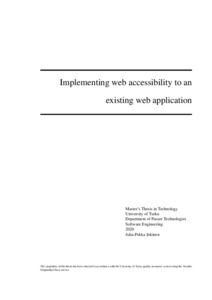Implementing web accessibility to an existing web application
Jokinen, Juha-Pekka (2020-11-30)
Implementing web accessibility to an existing web application
Jokinen, Juha-Pekka
(30.11.2020)
Julkaisu on tekijänoikeussäännösten alainen. Teosta voi lukea ja tulostaa henkilökohtaista käyttöä varten. Käyttö kaupallisiin tarkoituksiin on kielletty.
avoin
Julkaisun pysyvä osoite on:
https://urn.fi/URN:NBN:fi-fe20201214100527
https://urn.fi/URN:NBN:fi-fe20201214100527
Tiivistelmä
Web accessibility is becoming more and more important as societies around the world rely more and more on digital services. It enables the services to be used by many different kinds of users. It is starting to become a norm in public sector organisations, which sets up expectations and demands for web applications. When you have an existing educational web application like Sanako Connect, how do you go about implementing web accessibility into it?
That topic is explored through four research questions. First, as different countries and regions have regulations regarding web accessibility, and there are different web accessibility guidelines, what accessibility guidelines should be followed? Secondly, how those guidelines could be transformed into more concrete requirements?
The research questions become more practical from here on out. The third research question asks how to modify the development process so that accessibility will be thought of in future development and revisions of the software. This is vital because the application is in a constant flux of new features and refactoring, which means that web accessibility should be an integral part of development.
The final question is, what are the challenges and solutions when implementing the requirements to an existing application. Background into web applications and web accessibility is provided to find answers to the first two questions. The last two questions are explored through the starting phases of a web accessibility implementation project. The implementation project will also validate answers for the first two questions, as the guidelines and requirements will guide the development process and implementation.
Even though the implementation details are unique to this one product, the challenges and solutions are general enough that they support previously discussed approaches to web accessibility. The most important takeaway is that there rarely are valid arguments for not including web accessibility into new projects from the start. Including it afterwards is always the harder path to take.
That topic is explored through four research questions. First, as different countries and regions have regulations regarding web accessibility, and there are different web accessibility guidelines, what accessibility guidelines should be followed? Secondly, how those guidelines could be transformed into more concrete requirements?
The research questions become more practical from here on out. The third research question asks how to modify the development process so that accessibility will be thought of in future development and revisions of the software. This is vital because the application is in a constant flux of new features and refactoring, which means that web accessibility should be an integral part of development.
The final question is, what are the challenges and solutions when implementing the requirements to an existing application. Background into web applications and web accessibility is provided to find answers to the first two questions. The last two questions are explored through the starting phases of a web accessibility implementation project. The implementation project will also validate answers for the first two questions, as the guidelines and requirements will guide the development process and implementation.
Even though the implementation details are unique to this one product, the challenges and solutions are general enough that they support previously discussed approaches to web accessibility. The most important takeaway is that there rarely are valid arguments for not including web accessibility into new projects from the start. Including it afterwards is always the harder path to take.
